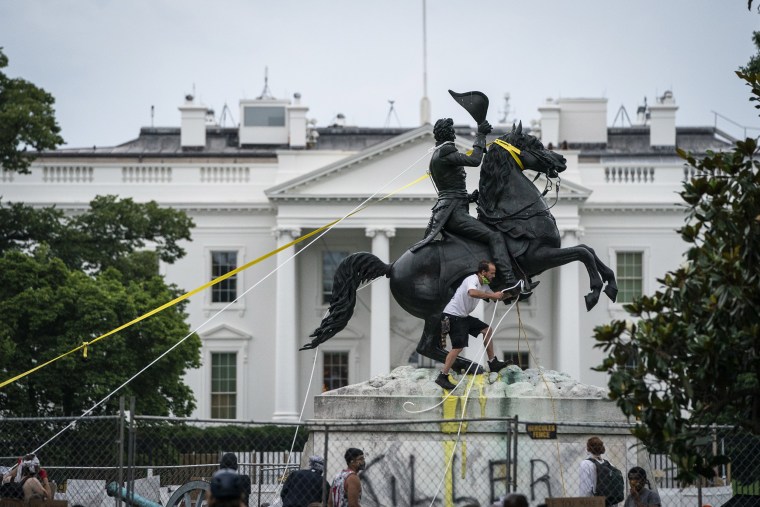WASHINGTON — Protesters defaced a statue of Andrew Jackson in Lafayette Square outside the White House on Monday night as they tried to topple it, according to the Interior Department and media reports.
The Jackson statue remained on its pedestal, according to The Associated Press. Videos posted on social media showed that the protesters had climbed on the statue and tied ropes around it, then tried to pull it off its pedestal, the AP said.
When asked about reports of pepper spray being used in Lafayette Park, a National Park Service spokesperson told NBC News: "I am still gathering information, but it is accurate that pepper spray was used to disengage the protesters from the statue and clear the area."
Interior Secretary David L. Bernhardt said in a statement that he had just left the scene at Lafayette Square "where another so called 'peaceful protest' led to destruction tonight. Let me be clear: we will not bow to anarchists. Law and order will prevail, and justice will be served."
He added that the Jackson statue has been "defaced by criminals who sought to topple the statue recognizing the seventh President of the United States. Law enforcement officers ensured that this would not happen."
The U.S. Park Police with assistance from Washington, D.C.'s Metropolitan Police Department and the Secret Service tried to prevent the destruction of the statue, a spokesperson for the Park Police told NBC News.
On Tuesday, the National Park Service erected an 8- to 9-foot fence around Lafayette Park. The fence had been placed around the park amid the nationwide anti-racism protests against police brutality following the killing of George Floyd while in police custody, but was later taken down as tensions between police and protesters lessened.
Trucks carried cement barricades to reinforce the fence and the Metropolitan Police Department closed a street adjacent to the park. However, a small group of peaceful protesters lined up in front of the police.
"Lafayette Park will be closed while the NPS assesses damage and begins to make repairs to statues and other park resources," said Katie Liming, a Park Service spokesperson.
Interior Department spokesperson Nicholas Goodwin said arrests were made in Lafayette Square but didn’t provide any further details.
On Tuesday morning, police clashed with a small group of protesters outside Lafayette Park as they moved a perimeter back several blocks.
President Donald Trump tweeted Monday night: "Numerous people arrested in D.C. for the disgraceful vandalism, in Lafayette Park, of the magnificent Statue of Andrew Jackson, in addition to the exterior defacing of St. John’s Church across the street. 10 years in prison under the Veteran’s Memorial Preservation Act. Beware!"
Trump told reporters Tuesday that law enforcement stopped an attack on a "great monument" and said "numerous people are in jail and going to jail today."
"We are looking at long-term jail sentences for these vandals and these hoodlums and these anarchists and agitators and call them whatever you want. Some people don’t like that language, but that’s what they are. They’re bad people, they don’t love our country, and they’re not taking down our monuments," he said.
Trump also criticized the vandalism during a speech Tuesday at the Students for Trump conference, hosted by the conservative Turning Point Action, in Phoenix, Ariz.
"They're tearing down statues, desecrating monuments and purging dissenters," Trump told the crowd, calling it "the behavior of totalitarians and tyrants."
Jackson, however, was a Tennessee slaveholder and signed a law that led to the expulsion of Native Americans east of the Mississippi River in which they were forcibly moved west by the federal government. According to the Library of Congress, about 4,000 Cherokees died on the march that became known as the "Trail of Tears."
Trump has expressed admiration for Jackson, who was a populist, including during a 2017 visit to the Hermitage, Jackson’s plantation. According to the Hermitage, Jackson owned about 150 slaves at the time of his death.
“Recent events have shown that vandals have been targeting, defacing and seeking to destroy historic public monuments, memorials and statues without discretion or regard for public discourse," a spokeswoman for the Park Police said in a statement. "The USPP is taking all precautions to protect these historical icons under the care of the NPS.”

